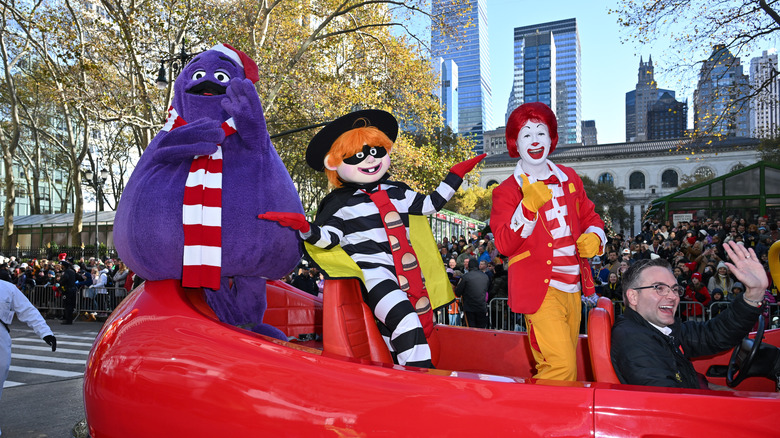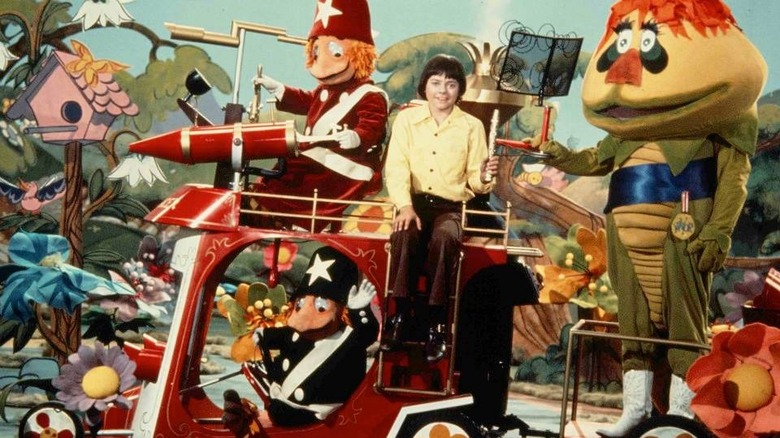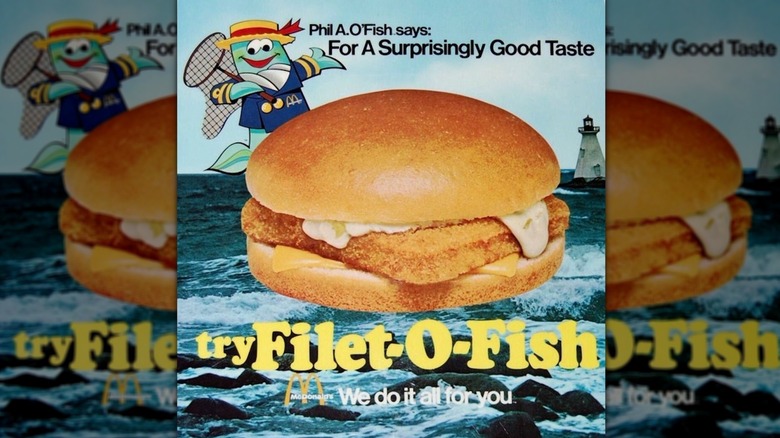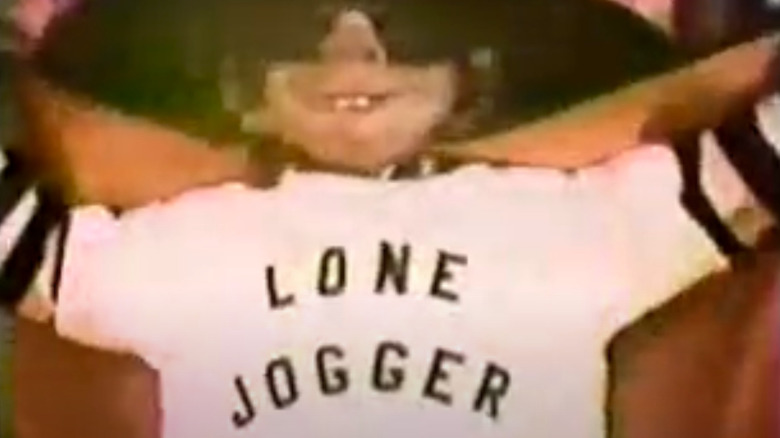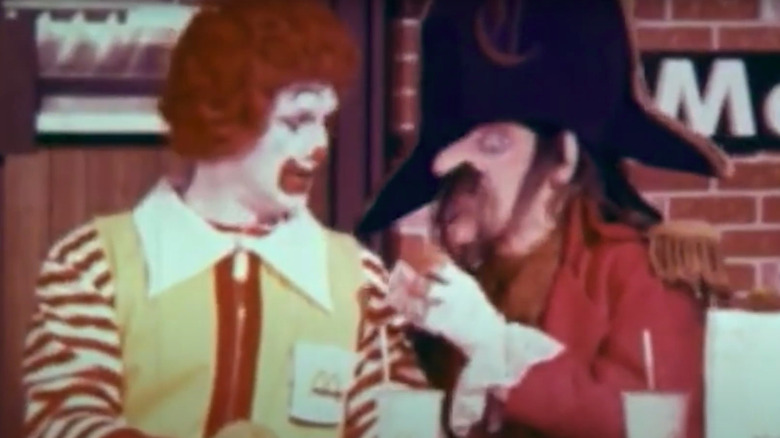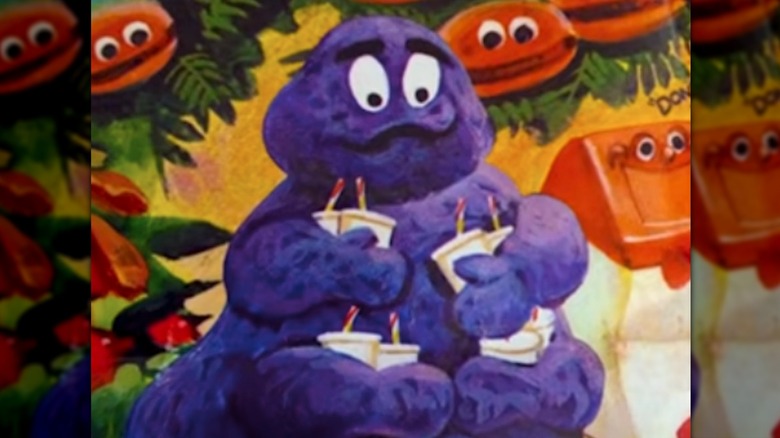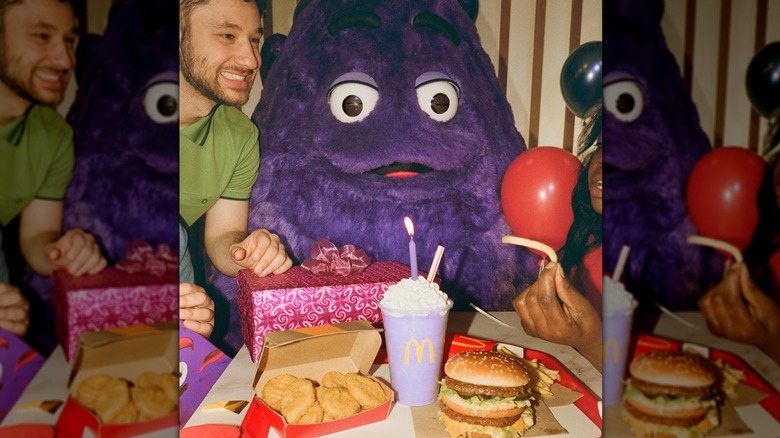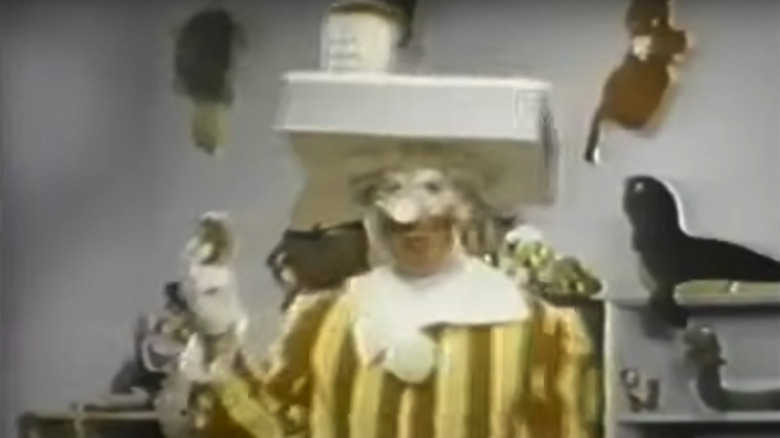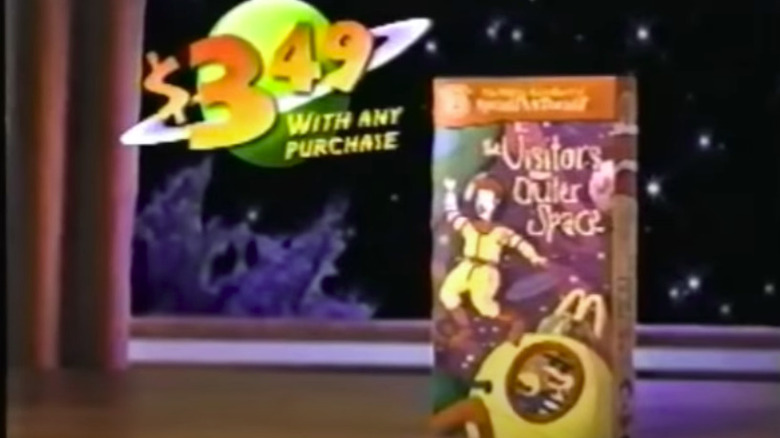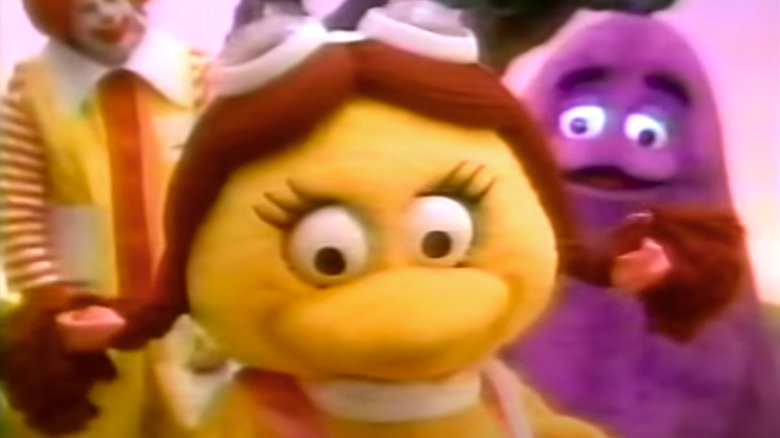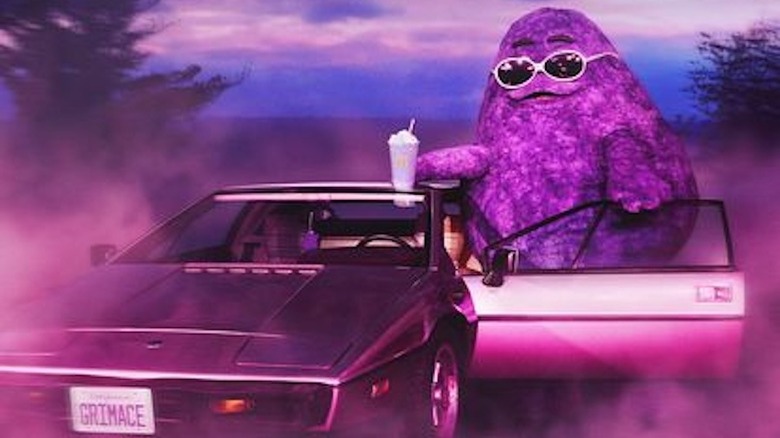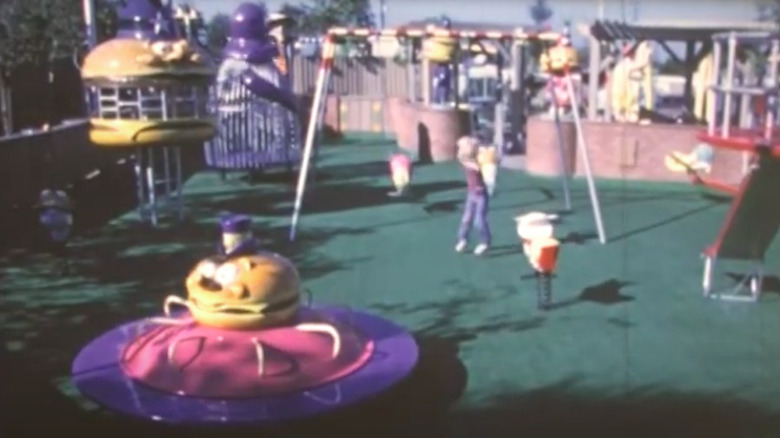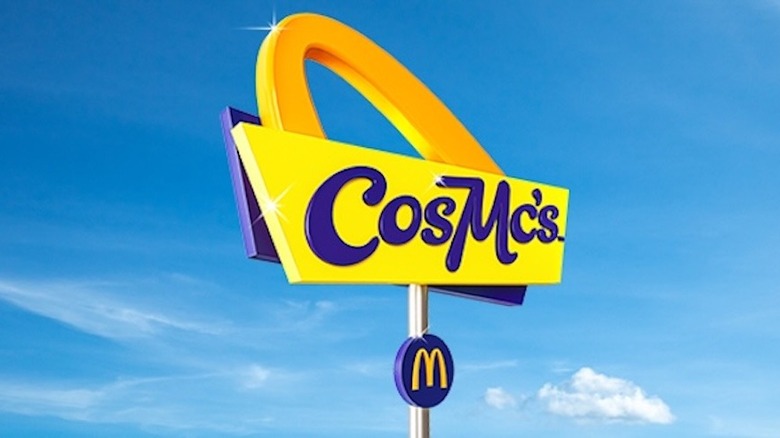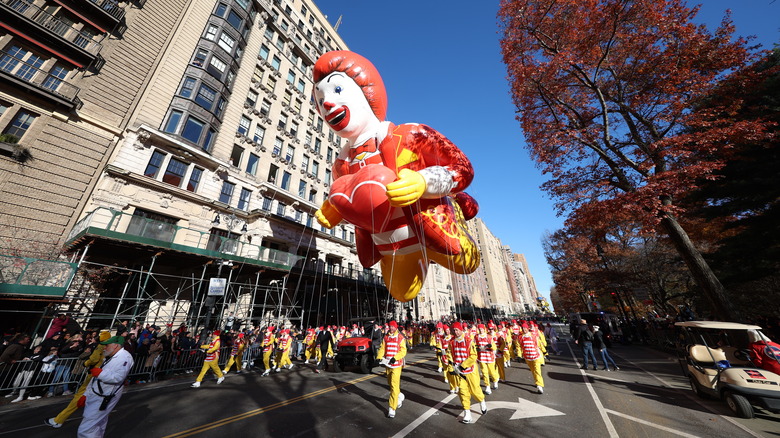Shady Things About The McDonaldland Characters
The fast food franchise starter kit is pretty basic and recognizable to any '90s kid. You'll want an iconic food of some kind, normally a cheeseburger or hamburger. Fries are an absolute must, and it's a good idea to have a kid's meal of some kind. And then the real kicker: a mascot.
While most chains have one major mascot like Burger King or Wendy's, McDonald's has made an entire universe surrounding its mascots: McDonaldland. Could the name be more creative? Sure. Is it simple enough to remember and ideal for name recognition? Absolutely.
If you visited a McDonald's restaurant or took in popular media from the '70s all the way through the early 2000s, there's a good chance you've seen some of this McDonaldland content. Its span sweeps from commercials to merchandise and even longer feature pieces. The characters are goofy, lovable, and whimsical, but there's also a whole lot about McDonaldland and its characters that is just a little shady.
McDonald's was sued over its characters
"H.R. Pufnstuf" is a cult classic kid's television show. Initially, it ran from September to December 1969 but was rerun several times over and syndicated. The show is about a young boy named Jimmy and the characters of Living Island. You don't have to look at images of the characters for too long before you begin to see the resemblance between the residents of Living Island and McDonaldland. The similarities are so striking that McDonald's found itself embroiled in a lawsuit over the fact.
Backtracking before the suit — and perhaps showing a clear connection and intent to copy — Needham, Harper & Steers originally asked "H.R. Pufnstuf" creators Sid and Marty Krofft if they were interested in an advertisement partnership between McDonald's and "H.R Pufnstuf." The advertising company was attempting to land the McDonald's account and wanted to offer the campaign as part of the agency's pitch. Even though there was interest and plenty of communication between Needham and the Kroffts, the partnership never came to pass. In fact, Needham claimed that McDonald's had canceled the campaign. Imagine Krofft's surprise, then, when they see an ad campaign featuring characters strikingly similar to those in "H.R Pufnstuf." It seemed McDonald's had changed just enough about the characters to ensure they weren't exact replicas and just different enough. It was only a matter of time before the case ended up in court, with a verdict winning the Kroffts $50,000.
Some mascots weren't part of McDonaldland
Even though McDonaldland has featured many characters, there are some McDonald's mascots that are not part of McDonaldland. Take the case of a fish hawking McDonald's popular fish sandwich, Phil A. O'Fish.
In 1962, the Filet-O-Fish became part of the McDonald's menu. The brainchild of franchisee Lou Groen, the sandwich was created to help combat a steep drop in sales every year during the Lenten season when Catholics local to Groen's restaurant would avoid the establishment in an effort to avoid eating meat. Good 'ol Phil appeared 14 years later, in 1976, to advertise McDonald's Filet-O-Fish sandwiches.
The name Phil A. O'Fish even hints at the sandwich's origins. With the last name of O'Fish, it includes the O' prefix, which is common to many Irish surnames, and dates back thousands of years. Since Catholicism was the chosen religion in most Irish homes, the mascot's name hints at the tight connection between Catholic customers avoiding meat and Groen's desire to create a fish sandwich alternative.
And yet, the talking fish character never appears in McDonaldland, even though there is a Filet-O-Fish Lake. Our guess is that McDonaldland already had Captain Crook advertising the sandwich, so the addition of a another character to McDonaldland may have been a little overboard. However, this begs the question: If McDonald's had Captain Crook, why did it need Phil?
Hamburglar was originally the Lone Jogger
Looking at him, you wouldn't imagine that the Hamburglar is the result of a glow up, but it most certainly was. When the Hamburglar was first introduced, he went by the name the Lone Jogger. Like something out of a prison escape movie, rife with vicious, solitary gangsters, the Lone Jogger didn't speak in an understandable language and had a wide brimmed hat that covered most of his face, though you could certainly make out a rather Pinocchio styled nose.
The Lone Jogger would become The Hamburglar moving into the 1980s, and by this time, he moved from a hardened criminal to a childlike character who loves burgers just a bit too much. He also learned to speak in words the audience could understand.
Hamburglar once had a partner
Any quality bad guy needs buddies, and the same is true for the Hamburglar, who had Captain Crook. In fact, before learning to speak more clearly, Crook was something of a translator for him, making sense out of his nonsensical sounds.
When McDonaldland first emerged, Captain Crook was among the original cast. Though he didn't don a hook like the fairy tale pirate with a similar sounding name, there's no doubt that the name relies heavily on this allusion. Crook's storyline revolves around Filet-O-Fish and the thieving of these sandwiches, like the Hamburglar, but for fish. In the 1980s, Crook must have seen the wrong in his ways and became more of a good guy then the pirate until fading into existence altogether.
Evil Grimace was originally a bad guy
Speaking of glow ups, Grimace has not always been the bubbly milkshake loving purple monster with a sweet and dopey demeanor. In fact, when he was first introduced, Grimace was something of a villain, even being called Evil Grimace. The milkshake version of Hamburglar, in fact. He also had four arms, all of which he used to steal and store milkshakes while on the run. He was frightening, not something a brand wants from a character intended to sell product, largely to children.
It didn't take long for the brand to correct this issue, dropping evil from the name, and Grimace soon became something of Ronald's right hand man. Even though Evil Grimace was short lived, his oddity still has enough spark in it to bring a glimmer of horror, as his recent viral status shows.
Grimace became a horror flick character
For the most part, the McDonaldland characters aren't a primary feature in most of McDonald's advertising or merchandise today. But every now and again, the brand comes up with a gimmick to celebrate the characters, and the lovable purple monster just got his very own time in the social media spotlight.
In June 2023, McDonald's released a line of Grimace Birthday Meals. It came with either a Big Mac or ten piece chicken nugget and French fries. For a drink, you got a purple birthday shake that was a berry and vanilla flavor. The light purple milkshake was an obvious draw, and it definitely made for a social media revival celebration of the little monster.
It wasn't long before the Grimace birthday meal took on a life of its own. Drawing on the oddity that was the purple birthday shake, TikTokers created short horror films following a sip of the milkshake. Rather than ignore the phenomenon, McDonald's played right into it, even creating a TikTok in which Grimace covers his eyes, pretending not to see. Fighting against trends and content creation doesn't pay off, so McDonald's made the decision to become a participant, playing with creators who grew up with McDonaldland characters. In effect, McDonald's slyly made these horror films into advertising.
Ronald McDonald's original costume is nightmare fuel
Ronald McDonald was another McDonaldland character who saw an evolution from his initial appearance. Before hitting national airways, Ronald McDonald ran on a smaller market in Washington D.C. Oscar Goldstein, a McDonald's franchisee in the area, recruited eventual weather superstar Willard Scott for the role. He starred in three total ads for the D.C. area.
In these early ads, you can just barely see the Ronald McDonald we know today in the rough draft version of those earliest ad spots. Ronald McDonald, still a clown, wore a large white tray hat with food on it, alarming large amounts of red mouth paint, and appeared to be a cross between clown and a scarecrow. Rather than the red nose, Scott's Ronald wore a cup, and his outfit was striped. The combination of all the pieces together is a little traumatizing, and later revisions of Ronald McDonald definitely create a more palatable character. This first attempt wouldn't have been a character who children would flock to.
When McDonald's began purchasing its franchises from its franchisees, Goldstein's locations included the Ronald character, and Scott was slated to become the national Ronald McDonald. However, at seemingly the last minute, Scott was told he was going to be replaced by someone else for the starring Ronald role.
Ronald McDonald almost wasn't a clown
Before making his way into the national advertising game, some consideration was given to making Ronald into a cowboy or even an astronaut. Either option would have been reflective of popular stories and news programs of the day. In fact, William Scott even made a commercial where he went to the moon to show McDonald's far reaching fandom.
Of course, regardless of his clown form, Ronald McDonald would continue to go on many adventures that often included unique costumes, like an astronaut. In one such example, as part of "The Wacky Adventures of Ronald McDonald," Ronald and the gang must save the Hamburglar after he has been abducted by aliens. The video was released in 1999, many years after Ronald McDonald's original introduction. Some '90s kids watching this video — once sold at McDonald's restaurant — will see that the art feels very similar to "Rugrats," and for good reason, as many of the animators worked on "Rugrats," as well. This animation style would be recognizable to many kids of the era, and it's another way McDonald's coyly ensured that McDonald's remain familiar feeling to its youngest customers.
Some characters have been seemingly discontinued
As brands grow, inevitably, there will be changes. For McDonaldland, that often means the coming and going of characters. Captain Crook, Mayor McCheese, and Birdie the Early Bird are just three examples of characters who were once featured in advertising that found their way into seemed retirement from the burger-laden land.
Some McDonaldland characters are more memorable than others. One example is Birdie the Early Bird. The sweet little character — a bird — didn't know how to fly right away. In fact, this became a storyline for the character in a commercial in which she learns how to take to the skies. Like many McDonaldland characters that are connected to one food item or another, birdies food items were the breakfast menu. She didn't make any dramatic exit, rather, she's just a character we rarely see anymore. Mayor McCheese was another of the McDonaldland characters who seemed to disappear following McDonald's court skirmishes.
Character appearances are inconsistent
McDonaldland originally rolled out as a giant advertisement for McDonald's, and it certainly branched into merchandise and other media, but the character appearances since its initial roll out have been inconsistent to say the least. It's been hard to trace which characters are still part of the McDonaldland lore and who precisely may be out, enjoying life somewhere beyond McDonaldland.
The Grimace Birthday meal is the perfect example of these characters finding their way back into the limelight (and our hearts), but it's far from the only instance. In January 2024, Hamburglar was up to his old tricks with the unveiling of McDonald's new method of making burgers. The chain switched out buns and began cooking onions into the patties. To mark such a momentous change, Hamburgler hopped in his new getaway car (the Burgercuda) and set on a quest to get some of these new burgers.
Admittedly, these two instances don't feel like an attempt to bring McDonaldland to life but rather draw in an audience that remembers the McDonaldland characters from their hayday. More than anything, these callbacks are not the same marketing tactic; rather, McDonald's is marketing to an audience that grew up with the characters, sliding down playground equipment featuring their favorite fast food faces.
McDonaldland Playlands seem to have disappeared too
McDonald Playlands were big a deal. Live nearby one, and you had it absolutely made as a kid. Though these Playlands eventually morphed into inside playgrounds that looked like every other playground, they weren't always that way.
In the 1970s, McDonald's tapped Setmakers, Inc. to create a playground that was highly themed after the McDonaldland characters. It was filled with equipment and decorations to make a child feel as though they were stepping into one of the McDonaldland commercials. In fact, these sets were in such the earliest days of McDonaldland that the Hamburglar even has his original (terrifying) look.
With times, these Playplaces evolved, often moving inside, and became the ideal place to hold a child's birthday party. Today, you'd be lucky to find one in your town. With cleanliness concerns emerging even before COVID-19, after the pandemic took hold, most all play areas in McDonald's restaurants closed entirely, with no outdoor alternative offered.
CosMc took menu items for experimentation
In 1987, an alien landed in McDonaldland. Ronald, Grimace, and the Professor came upon the part vehicle, part character being. The creature — who Grimace initially called a flower pot — identifies himself as CosMc and proceeds to tell the gathered characters that he has arrived on a trade mission. Ronald invites CosMc to a picnic for fries, burgers, and shakes, but CosMc snatches the food, giving Ronald a bouquet of flowers instead. Ever the problem solver, Ronald wields a magnet to find the alien who concedes to sharing. CosMc takes off after lunch to go share the news of McDonald's with his own kind. After this initial advertisement, viewers saw McDonald's own alien mascot two more times in 1989 and 1992.
Now, McDonald's is opening spin off restaurants named after the character called CosMc's. The whole premise here is just a little shady; cute, we suppose, but the idea is that CosMc has returned after over three decades away to share his food experiments with the people of earth is eyebrow raising. The smaller chain is beginning with only a few locations, but it's easy to imagine that success might mean more to come.
Items on the CosMc's menu are what we might call McDonald's adjacent. Here, you'll find inventive drinks, treats, and even an Egg McMuffin, among some other breakfast favorites from McDonald's restaurants. The drinks are more adventurous than the usual fare, but looking at the menu, it feels like more of a cafe than anything else.
McDonaldland characters marketed to children
So, why did McDonald's create McDonaldland? We believe the answer is simple: To market directly to children. Looking at the characters and how they evolved over time, that much becomes exceedingly clear. There was no real reason to reframe an Evil Grimace other than the fact that he scared kids. The Lone Ranger was a terrifying looking villain who seemed to be filling the role, but the reimagined Hamburglar was more puppet-esque and not a stranger-danger sorta fellow. The too scary characters' redesigns show that McDonald's had a goal and needed to change the characters to better suit that goal. Today, Ronald appears in similar context to other kid centered characters, as giant balloons in major parades, for example.
Taking a look at some of the commercials, and it becomes even clearer. The French Fry Kids are the best example of this. These little characters were supposed to be little boy and girl creatures that went gaga over fries, taking them at every turn. In a 1987 commercial, the Fry Kids appear alongside Ronald and a gaggle of children playing inside a McDonald's restaurant. As adults watching the commercial, we're left wondering, "Where are the adults?" The kids are having a jolly time, but adults are nowhere to be found, and it's clear the ad is aiming for a younger demographic, like the children playing in the commercial.
